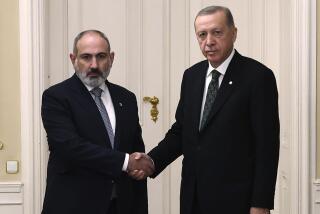Soviets Reject Armenian Border Change
- Share via
MOSCOW — The Soviet government decreed Wednesday that pressure from ethnic Armenians to redraw the boundaries of the Armenian republic is “unacceptable” and instructed law enforcement agencies to “take every necessary measure to ensure public order.”
The decision on the issue came in a resolution adopted by the Presidium of the Supreme Soviet, the nation’s highest legislative authority, and effectively quashes Armenian hopes to have the largely Armenian enclave of Nagorno-Karabakh, in the neighboring republic of Azerbaijan, linked to Armenia.
At least 32 people have been killed and nearly 200 injured in disturbances in the two republics since Armenians began demonstrations about a month ago to press for a change in the borders.
The demonstrations began peacefully, with hundreds of thousands of Armenians filling the streets of Yerevan, the capital of the republic, many of them carrying photographs of Soviet leader Mikhail S. Gorbachev and carrying banners invoking his concepts of glasnost, or openness, and perestroika, or restructuring. They apparently hoped that the time was ripe to press for resolution of a long-held grievance.
From the beginning of the demonstrations, the issue was regarded by many analysts here as a test for Gorbachev’s policies.
Gorbachev himself addressed the meeting of the Presidium, according to Tass, the official Soviet news agency. Although the Soviet leader’s remarks were not made public, it seemed clear that glasnost, as it relates to the Nagorno-Karabakh issue, had reached its limit. The Presidium’s five-point resolution put a heavy emphasis on law and order.
The document instructed officials of Azerbaijan and Armenia to “declare vigorously against any nationalistic and extremist manifestations.” Party leaders in both republics, the statement said, should adopt measures “to consolidate socialist legality and public order.” Finally, it directed the office of the public prosecutor and the Interior Ministry--which directs law enforcement agencies--to “take every necessary measure to ensure public order and protect lawful interests of the population.”
The resolution described the situation in the two republics as “detrimental” and described as “intolerable” the attempt to “resolve complicated national-territorial issues through pressure on state authorities in an atmosphere in which emotions and passions are whipped up.” The redrawing of national and administrative borders, the resolution declared, “can lead to unpredictable consequences.”
The consequence that may have concerned the Soviet leadership most is the specter of a chain reaction of nationalist protests in the Soviet Union, a nation with more than 120 nationalities, some of them restive. There were nationalist disturbances in Kazakhstan in 1986 and protests this year in the Baltic states of Lithuania, Latvia and Estonia.
Diplomatic observers suggest that other nationalities with grievances to air had been watching the Armenian situation with interest and were likely to follow its example if it had met with success.
It was unclear how Armenian leaders would respond to Wednesday’s decree.
There were small protests in Yerevan on Monday and Tuesday, apparently over an article published Monday in Pravda, the Communist Party newspaper, which, in effect, was a preview of the decision reached by the Presidium on Wednesday. The article, a lengthy discussion of the history of the region and an analysis of the current conflict, indicated that there would be no change in the disputed territory.
The Pravda article continued to stir controversy after its publication. In an unusual turn of events disclosed by Armenian dissidents, one of the article’s three authors, Yuri Arakelyan, protested that the article had distorted the facts.
In a telegram to a senior editor of the newspaper, Arakelyan said:
“As a Pravda staff member, I recognize with deep shame that from above they are trying to confuse the already complicated tangle of relations between nationalities. Putting my signature at the bottom of dishonest materials of the Communist Party of the Soviet Union, you have insulted me before the whole country and must cleanse me of this shame yourselves.”
Paruir Khairikyan, a member of the “Karabakh Committee” organizing the Yerevan protests, was arrested in Moscow hours after he read Arakelyan’s telegram to reporters. Dissident sources said he was flown back to Yerevan.
Armenians had declared a moratorium on demonstrations until Saturday, when a special plenary meeting of the party’s Central Committee is to take up the nationalities issue. The meeting was announced last month by Gorbachev, leading some Armenian activists to believe that the issue might be resolved in their favor.
In view of the stern tone of the Presidium’s resolution, it seems likely that authorities will employ police or the military to prevent any demonstrations.
A heavy force of troops is keeping the peace in the Azerbaijani city of Sumgait, where 32 people were killed in rioting Feb. 28 and 29.
Although Soviet spokesmen describe the situation there as “normal,” a dusk-to-dawn curfew remains in effect. The Soviets have not said how many troops are in the city, but witnesses have suggested there are several thousand, equipped with light tanks and armored cars and riot gear.
More to Read
Sign up for Essential California
The most important California stories and recommendations in your inbox every morning.
You may occasionally receive promotional content from the Los Angeles Times.













